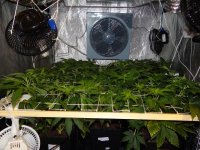greenops
Member
In my last run I lost a battle against Powdery Mildew.
After cleaning everything and starting from scratch I was still afraid of PM and that's why used a local systemic fungicide called Rondo Combi http://www.maag-garden.ch/de/produkte/rondo-combi.htmlhttp://www.maag-garden.ch/de/produkte/rondo-combi.htmlhttp:// to prevent another PM infestation.
Even though the Rondo Combi is intended and tested for fruits (can be used 3 weeks before harvest), the local grow shops sell it and do recommend it. I applied it once 4th week in veg then once at 12/12 switch, before any buds production.
Only after application I took the time to research about the product and now I really wished I haven't used it at all.... the active ingredient is Difenoconazole.
Apparently the LC50 (lethal concentration) by inhalation in rats is at > 5.17 mg/l, 4 h.
I understand that what's really relevant is the level of Difenoconazole by harvest time, which will be 10 weeks after the last application. But since I don't know where I can get this tested, I'd like to know the concentration that I initially sprayed the plants with in mg/l.
Rondo Combi came in a small 75 ml bottle containing 23.3 % Difenoconazol and a pack of powder (Dithianon). Dithianon isn't systemmic so I'm not too worried about it. Those two ingredients have to be diluted in 5l Water.
I sprayed at most 500ml on 8 plants.
My attempt in calculating this:
I don't know if I did this correct. but if 5.17 mg/l can kill rats i don't wanna find out what 3'495 mg/l can do to humans!
So any help is greatly appreciated!
After cleaning everything and starting from scratch I was still afraid of PM and that's why used a local systemic fungicide called Rondo Combi http://www.maag-garden.ch/de/produkte/rondo-combi.htmlhttp://www.maag-garden.ch/de/produkte/rondo-combi.htmlhttp:// to prevent another PM infestation.
Even though the Rondo Combi is intended and tested for fruits (can be used 3 weeks before harvest), the local grow shops sell it and do recommend it. I applied it once 4th week in veg then once at 12/12 switch, before any buds production.
Only after application I took the time to research about the product and now I really wished I haven't used it at all.... the active ingredient is Difenoconazole.
Apparently the LC50 (lethal concentration) by inhalation in rats is at > 5.17 mg/l, 4 h.
I understand that what's really relevant is the level of Difenoconazole by harvest time, which will be 10 weeks after the last application. But since I don't know where I can get this tested, I'd like to know the concentration that I initially sprayed the plants with in mg/l.
Rondo Combi came in a small 75 ml bottle containing 23.3 % Difenoconazol and a pack of powder (Dithianon). Dithianon isn't systemmic so I'm not too worried about it. Those two ingredients have to be diluted in 5l Water.
I sprayed at most 500ml on 8 plants.
My attempt in calculating this:
- The 75 ml solution contains 17.475 ml Difenoconazol (23.3%).
- 17.475 ml Dif = 17'475 mg (this conversion is inaccurate, because the medium has to be fresh water "1 gram (gm.) = 1 millilitre (ml.)"
- 17'475 mg Dif mixed in 5l water ---> 3'495 mg/l
I don't know if I did this correct. but if 5.17 mg/l can kill rats i don't wanna find out what 3'495 mg/l can do to humans!
So any help is greatly appreciated!



 ).
).
